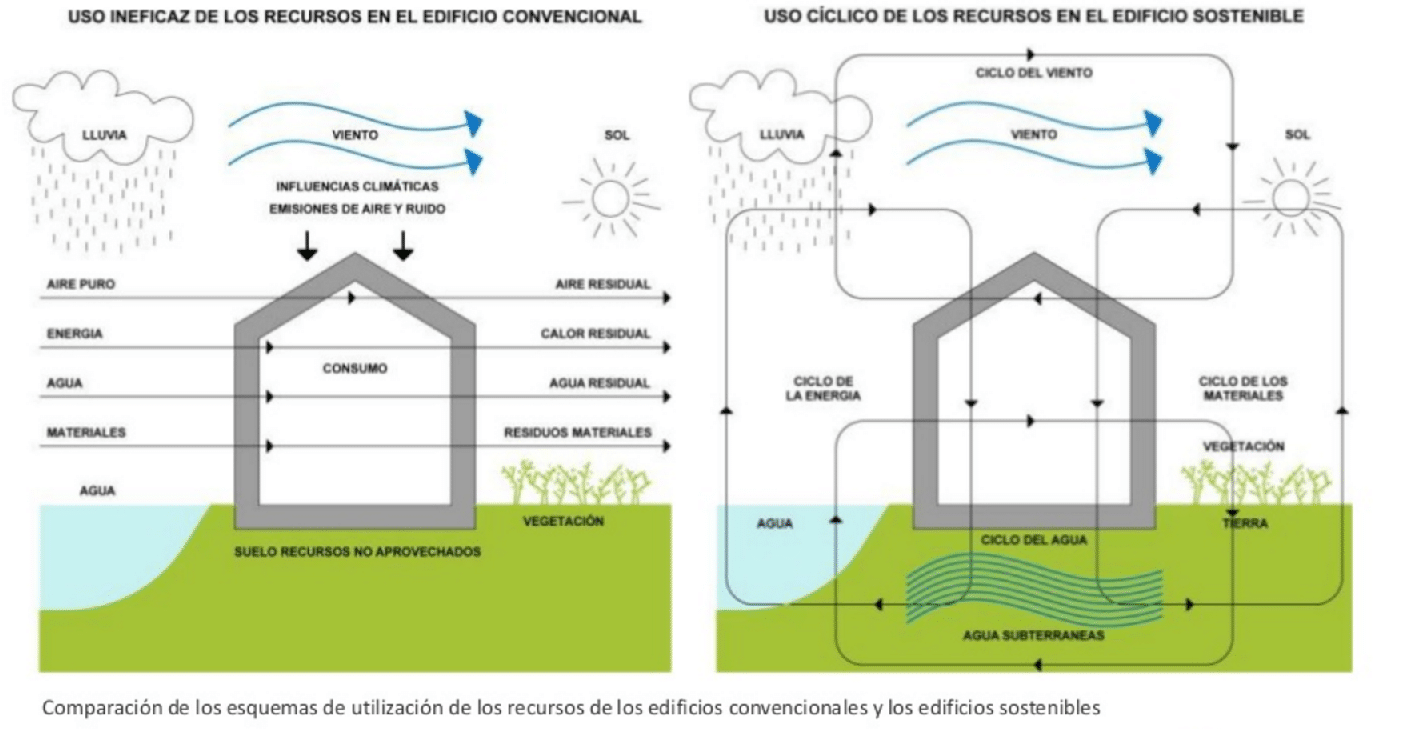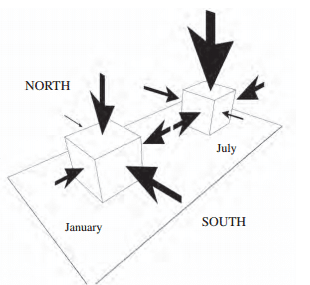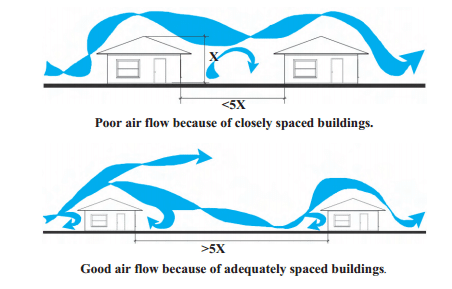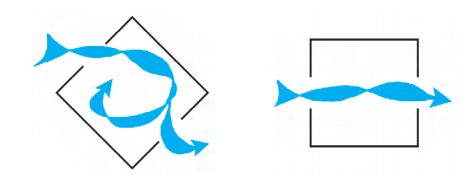-
Phone Number
-
Email Address
Multiple agents intervene in a coherent architecture and efficient, although many times we forget -I think- key points that are economically costly practically “null” and we focus more on having a more efficient installations or of a more “spectacular”.
There are other ways to shape the architecture that It will bring us benefits. Ventilation strategies natural thanks to the prevailing winds that affect the architecture that we can implement, in addition to taking advantage of the sun and its benefits.
The plot and the shape of the building can be decisive in reducing or improving heat gains by solar radiation and promote the direction of the winds in architecture . An example…

For this, it is necessary to consider different points of the environment, winds, sunlight, accesses, obstacles…etc. A compendium of elements, which well studied and executed from start will cause future energy savings, although I think I remember that we will not be remembered in architecture for raise and properly execute these aspects.
Obviously it is not the same to build in the North of Spain than in the South, but the checkpoints that we intend to show before starting the construction of a project can be adapted according to their climatic situation.
Content menu:
In this case we focus on reducing loads solar (solar heat) and the use of natural ventilation . curiously also has a reverse game, the majority of revised points, the opposite would be to obtain some higher solar loads.
Remembering the “reverse game” discussed above, we analyze points that we should consider in our architecture project.
The solar heat gains have their greatest impact on surfaces perpendicular to the sun's rays, that is to say on the ceilings and the East and West walls throughout the year, and on the South wall in the months of boreal winter (November, December, January). In buildings facing with the narrower façades to the East and West reduce exposure to the sun at its lowest angle and you get better shading possibilities.


Locate the building on the plot so that it that elements of the urban context are used to block or increase heat gains or maximize the wind chill potential predominant.

Elements of the urban environment such as unevenness topographic features, masses of vegetation or nearby buildings can cast shadows on plots that can be tapped like sunscreens. (We remember the manuals article in urban design with more than 30 documents from relevance)
Here we must understand that the location of the Sun is very important with reference to the building. if we have it in account all are benefits and in the following scheme are palpable (Guidance for Spain):
Using elements of landscaping to improve the microclimate of the plot and shade the building.
The location of elongated floors with the most narrow oriented within an angle of 15º to 20º east-west, will reduce heat gains in the mornings and in the afternoons when the sun acts with its lowest angles. Although the south façade receives high insolation during the boreal winter, this can be reduced with roof eaves.
Use the planters as elements of volumetry to dampen heat gains solar.
We can improve the microclimate of the plot with the help of masses of vegetation, hedges, planters and other elements. Shading of walls and roofs with bushes, trees leafy trees and pergolas can reduce solar heat gains through these enclosures.

All kinds of trees and shrubs that are near the building should be selected so as to produce the adequate shade and at the same time allow the passage of air. The vegetation absorbs solar radiation and shades the ground which contributes to lowering the surface temperature. To the At the same time, it refreshes the surrounding air by transpiration of water vapor.
Use shading on surfaces paved exteriors to reduce the temperature.
With reference to paved surfaces sunny conditions increase the temperature of the environment and affect the visual comfort.
Air temperatures above paved areas sunny areas, such as parking lots, patios, and streets internal can be up to 7º C higher than on the surfaces not paved sunny, and up to 14º C higher than the shaded unpaved areas.
Define outdoor paved areas to avoid reflection of surface heat from the surroundings immediately.
Dark colored materials such as asphalt, they absorb, conduct and re-radiate heat. The materials of colors in the works as light ones such as concrete, absorb, conduct and re-radiate significantly less heat but cause glare.
Use as transit flooring exterior light elements and little paved surface, to reduce solar heat gains and glare.
Openwork pavers allow vegetation to grow in the empty spaces. They are suitable for transit areas such as parking lots and garages. They are a good substitute for asphalt or concrete as they reduce the total area of these materials without removing the function as rolling surface or parking.

Use set of volumes in the facades to create shadows.
Different planes that make up volumes, with projections and incoming, produce a set of shadows of their own, thrown through the building, which decreases the assimilation of heat through of the envelope and favor interior environments less hot. Of interest see the article that plans are offered free ecologies houses to download with 28 designs large architectural firms)
Take advantage of the high thermal inertia of the floor as a design element.
At a certain depth the temperature of the ground remains constant and is usually less than the temperature abroad. Also, a layer of earth can act as an insulator additional. The temperature damping that occurs It depends on the depth and the type of soil.
To cushion the day-night variations, the thickness should be 20 – 30 cm, to cushion the variations between days of different temperatures, thickness from 80 to 200 cm, and for cushion winter-summer variations, thicknesses from 6 to 12 m.

Provide ample space between buildings following the direction of the flow of wind.
The seeing in architecture should be considered as one more element at the time of design given that It will provide us with some advantages over ventilation natural that we must take into account. In the following schemes, we can check the effects caused by the winds in the architecture on the building.

Given a distance between buildings of at least 5 times the height of the upstream building offers greater ventilation opportunities for the building downstream. We have to learn to use the wind in the architecture to take advantage of its features.
Conveniently locate the buildings for provide good ventilation around the structure urban. In the following diagram of winds over a group of houses we can verify its performance:
When we observe the airflow in a building creates a high-pressure area in the front face and low pressure on the back face and on the faces parallel to the direction of the wind. The buildings aligned in the direction of the wind create wind shadows to the other buildings that are water below and consequently poor ventilation.
This situation can be improved by orienting the buildings at a certain angle relative to the prevailing direction of the wind. This also increases the distance effective between buildings.
Sometimes, the orientation of the building according to the solar trajectory is in contradiction with that of the prevailing winds, but a studied disposition of the exterior constructive elements, of the volumetry and of the vegetation can change the direction of moving air providing different advantages over construction designed.
Use the volume of the building to stimulate air circulation inside the building.
For spaces with openings in opposite walls, orient the room 45% from the direction of the wind to improve the flow of air. The rooms oriented to 45% with respect to the prevailing wind direction increase their airflow in 20%.

On a facade with windows, oriented 45° in relation to the wind, the placement of a wall or protruding volume at the end can double the positive pressure of the wind. yes for him otherwise the wall or volume is placed before the windows, the pressure in front of them is reduced and the flow is reduced inwards.
Use the shapes and orientation of the ceilings to stimulate air circulation inside the buildings.

According to the angle of inclination and the orientation of the water from a roof can be used to divert the trajectory original wind, and in this way make better use of its dynamic force to ventilate the rooms.
The slope of the roof in favor of the wind will produce greater pressure on the incidence façade than flat roofs, for how much the wind trajectory deviates upwards and produces a greater mass of air at negative pressure to leeward. The higher the slope, the better the effect.
Roofs with opposite slopes to the incidence of the winds produce a smaller negative pressure effect, due to that the air will tend more quickly to restore its trajectory original to return to the soil surface.
Gabled roofs oriented perpendicular to the incidence of winds in the construction and with little slope will allow faster restoration of the leeward wind path, therefore the lower the difference between overpressure and depression around the volume. With hipped roofs the effect is more obvious.
Flat roofs with perimeter corridor type eaves The pressure fields around the volume will decrease. This situation can be improved by creating rising auctions to the perimeter of the eaves.
Separate the building from the ground to stimulate air circulation around and within the environments.
When the wind rubs against the ground, it reduces air movement and makes it necessary to elevate the building so that the speed of the air passing through it is greater. This allows the envelope to give off heat by convection. Actually there are many technical and construction details that we must begin to understand, with the article on techniques of construction of bioclimatic houses we provide detailed plans to download and be able to work.
——————
Retrieved from:
Indeed, there are many factors that will determine the final form of a building but we intend to show that the game between form-wind-sun can be a good base objective for any project architecture.